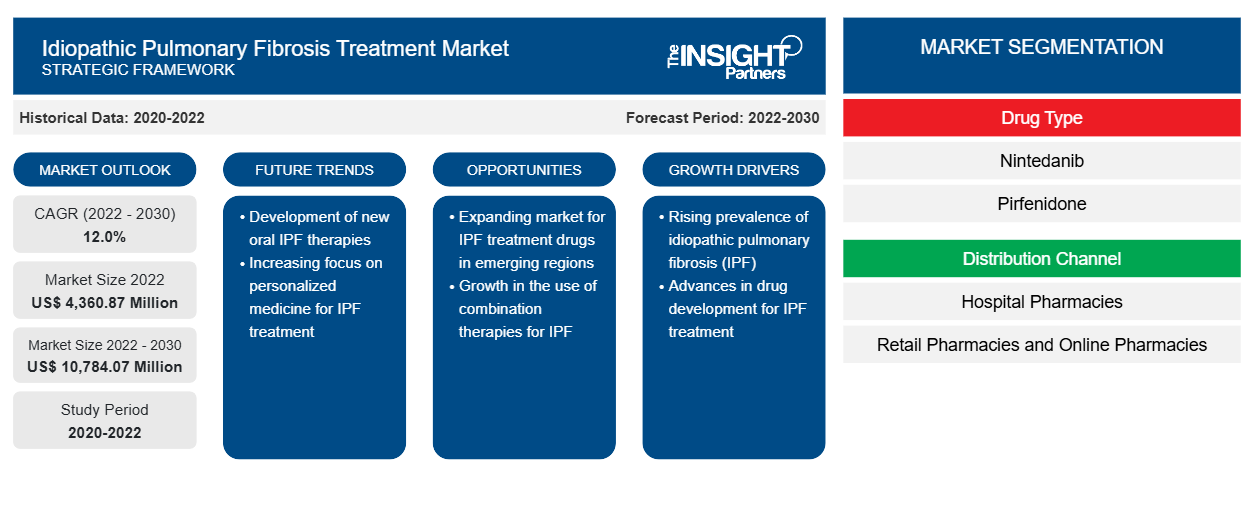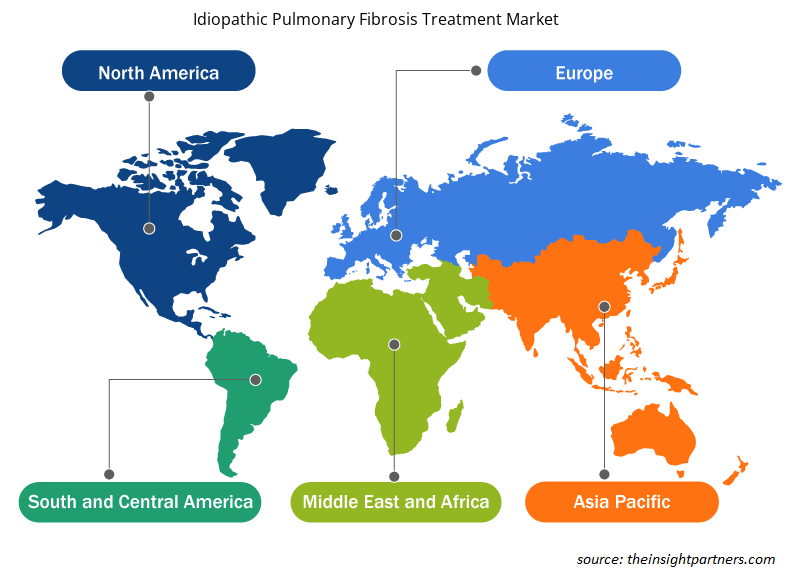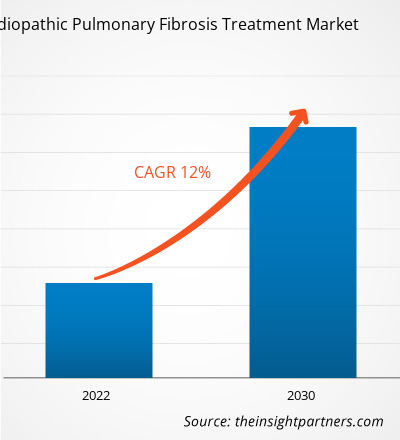[Research Report] The idiopathic pulmonary fibrosis treatment market size is projected to surge from US$ 4,360.87 million in 2022 to US$ 10,784.07 million by 2030; the market is estimated to grow at a CAGR of 12.0% during 2022–2030.
Analyst Perspective:
Idiopathic pulmonary fibrosis is a chronic condition that affects the tissue surrounding the alveoli in the lungs. It develops when lung tissues become stiff and thick for unknown reasons, and these changes result in permanent scarring in the lungs over time, which makes breathing difficult among patients. Currently, there is no precise cure for idiopathic pulmonary fibrosis. Treatments such as pulmonary rehabilitation, medicines, and surgical procedures slow down lung damage and help enhance the quality of patients’ lives.
The growing prevalence of idiopathic pulmonary fibrosis and an increasing number of people smoking cigarettes propel the demand for effective treatment drugs in the coming years. Ongoing research work to introduce effective drugs for idiopathic pulmonary fibrosis treatment is likely to further benefit the market in the future. Currently, healthcare spending has been increasing in both developed and emerging markets, which is expected to encourage manufacturers in this market to consolidate their efforts focused on developing new and innovative products.
Market Overview:
Fibrosis is the deposition of connective tissue that occurs as part of the normal healing process or the deposition of excess tissue that occurs as a pathological process. Idiopathic pulmonary fibrosis affects connective tissue in the lungs and alveoli (air sacs in the lungs). The condition may cause shortness of breath among people while performing their routine tasks, which aren’t tiresome for people in good health. The growth of the idiopathic pulmonary fibrosis treatment market is attributed to the growing burden of fibrotic conditions and an upsurge in the number of people smoking cigarettes. The rapid-paced research and development activities, leading to technological advancements in treatments, are expected to provide growth opportunities for the idiopathic pulmonary fibrosis treatment market in the coming years.
Customize This Report To Suit Your Requirement
You will get customization on any report - free of charge - including parts of this report, or country-level analysis, Excel Data pack, as well as avail great offers and discounts for start-ups & universities
Idiopathic Pulmonary Fibrosis Treatment Market: Strategic Insights

- Get Top Key Market Trends of this report.This FREE sample will include data analysis, ranging from market trends to estimates and forecasts.
You will get customization on any report - free of charge - including parts of this report, or country-level analysis, Excel Data pack, as well as avail great offers and discounts for start-ups & universities
Idiopathic Pulmonary Fibrosis Treatment Market: Strategic Insights

- Get Top Key Market Trends of this report.This FREE sample will include data analysis, ranging from market trends to estimates and forecasts.
Market Driver:
Growing Burden of Idiopathic Pulmonary Fibrosis Drive Idiopathic Pulmonary Fibrosis Treatment Market
According to data from the American Lung Association, updated in November 2022, approximately 50,000 new cases of idiopathic pulmonary fibrosis are diagnosed in the US each year. Symptoms of this condition are more noticeable in patients of age 50–70. According to an article published in the British Medical Journal in September 2022, the estimated prevalence of idiopathic pulmonary fibrosis in specialized care units in 2021 was 36.0 per 100,000. The number of patients suffering from idiopathic pulmonary fibrosis is increasing worldwide due to common risk factors such as aging, obesity, high blood pressure (hypertension), or family history, and the condition is becoming a significant socioeconomic burden for economies. Therefore, the increasing number of patients with idiopathic pulmonary fibrosis propels bolsters the fibrotic disease treatment market growth.
Segmental Analysis:
Based on drug type, the idiopathic pulmonary fibrosis treatment market is segmented into nintedanib, pirfenidone, and others. The nintedanib segment held a larger market share in 2022. The others segment is anticipated to register a higher CAGR of 46.3% during 2022–2030. Pirfenidone and nintedanib are the popular medicines prescribed to treat fibrotic diseases.
Regional Analysis:
North America dominates the global idiopathic pulmonary fibrosis treatment market. The market in North America was valued at US$ 2,362.95 million in 2022 and is projected to reach US$ 5,527.28 million by 2030; it is expected to register a CAGR of 11.2% during 2022–2030. The North American idiopathic pulmonary fibrosis treatment market is segmented into the US, Canada, and Mexico. The increasing burden of idiopathic pulmonary fibrosis and technological advancements in treatments benefit the idiopathic pulmonary fibrosis treatment market in North America. Product launches and strategic initiatives by key market players also contribute to the market growth. With the growing number of research and development activities to treat idiopathic pulmonary fibrosis, improved drugs are being introduced into the market, which results in better access to medicines for a wider patient pool. Further, extensive FDA approvals in the region encourage companies to launch technologically sophisticated products.
With the rising prevalence of idiopathic pulmonary fibrosis and high healthcare expenditure, Europe holds the second largest share in the global fibrotic disease treatment market. Germany is expected to dominate the European idiopathic pulmonary fibrosis treatment market due to better access to technologically advanced products and services in the healthcare sector.
Asia Pacific is expected to register the fastest CAGR in the global idiopathic pulmonary fibrosis treatment market during 2022–2030. The projected market growth can be credited to the widespread acceptance and adoption of cutting-edge technologies that produce accurate results in a significantly shorter time.Healthcare industries across the region are leveraging innovations in artificial intelligence, automation, and digital transformation, driving efficiency and productivity medical professionals. The ongoing transformation in various industries strengthens businesses and economies across Asia Pacific, allowing them to position themselves as the fastest developing hub with a dynamic and forward-thinking approach to sustainable progress.
Key Player Analysis:
The idiopathic pulmonary fibrosis treatment market analysis is based on key players such as Genentech, Inc. and Boehringer Ingelheim International GmbH.
Idiopathic Pulmonary Fibrosis Treatment Market Regional Insights
The regional trends and factors influencing the Idiopathic Pulmonary Fibrosis Treatment Market throughout the forecast period have been thoroughly explained by the analysts at Insight Partners. This section also discusses Idiopathic Pulmonary Fibrosis Treatment Market segments and geography across North America, Europe, Asia Pacific, Middle East and Africa, and South and Central America.

- Get the Regional Specific Data for Idiopathic Pulmonary Fibrosis Treatment Market
Idiopathic Pulmonary Fibrosis Treatment Market Report Scope
| Report Attribute | Details |
|---|---|
| Market size in 2022 | US$ 4,360.87 Million |
| Market Size by 2030 | US$ 10,784.07 Million |
| Global CAGR (2022 - 2030) | 12.0% |
| Historical Data | 2020-2022 |
| Forecast period | 2022-2030 |
| Segments Covered |
By Drug Type
|
| Regions and Countries Covered | North America
|
| Market leaders and key company profiles |
Idiopathic Pulmonary Fibrosis Treatment Market Players Density: Understanding Its Impact on Business Dynamics
The Idiopathic Pulmonary Fibrosis Treatment Market is growing rapidly, driven by increasing end-user demand due to factors such as evolving consumer preferences, technological advancements, and greater awareness of the product's benefits. As demand rises, businesses are expanding their offerings, innovating to meet consumer needs, and capitalizing on emerging trends, which further fuels market growth.
Market players density refers to the distribution of firms or companies operating within a particular market or industry. It indicates how many competitors (market players) are present in a given market space relative to its size or total market value.
Major Companies operating in the Idiopathic Pulmonary Fibrosis Treatment Market are:
- C.H. Boehringer Ingelheim International GmbH
- Bristol-Myers Squibb Company
- F. Hoffmann-La Roche Ltd
- AstraZeneca
- Shionogi and Co. Ltd.
Disclaimer: The companies listed above are not ranked in any particular order.

- Get the Idiopathic Pulmonary Fibrosis Treatment Market top key players overview
Recent Developments:
Inorganic and organic strategies such as mergers and acquisitions are highly adopted by companies in the idiopathic pulmonary fibrosis treatment market. A few recent developments are listed below:
- In May 2023, Boehringer Ingelheim initiated the clinical development of BI 765423, a breakthrough IL-11 inhibitor antibody. The Phase 1 study (NCT05658107) focused on evaluating its safety, tolerability, and pharmacokinetics in healthy volunteer subjects. Preclinical studies have shown promising results of this anti-IL-11 drug in inhibiting and potentially reversing fibrosis in various fibrotic cases.
- In October 2022, Boehringer Ingelheim enrolled the first US patient in the FIBRONEER-IPF Phase III study evaluating BI 1015550. BI 1015550 is an experimental phosphodiesterase 4B (PDE4B) inhibitor discovered for treating individuals suffering from idiopathic pulmonary fibrosis. The study is a part of the global FIBRONEER program, which includes two Phase III studies: FIBRONEER-IPF in patients with idiopathic pulmonary fibrosis and FIBRONEER-ILD in adults with other progressive fibrosing interstitial lung diseases (ILDs).
- In September 2022, Bellerophon Therapeutics, Inc. announced that the FDA accepted the trial size reduction application for its current REBUILD Phase 3 registration trial of INOpulse, indicated for the treatment of fibrotic interstitial lung disease (LD).
- In May 2022, ArisGlobal, a global leader in drug safety solutions, acquired Boehringer Ingelheim's BRASS digital innovation. The acquisition enabled the former to enhance its LifeSphere technology platform by integrating BRASS into LifeSphere Clarity. This integration has contributed to the advancement of pharmacovigilance and patient safety across the industry. Moreover, ArisGlobal has expanded its clinical diagnostics business presence in various regions worldwide, consolidating its global position.
- In March 2022, Bristol Myers Squibb, a leading pharmaceutical company, announced the acquisition of Turning Point Therapeutics, Inc. for US$ 76.00 per share through a definitive merger agreement. This acquisition has significantly strengthened Bristol Myers Squibb's global presence in the pharmaceutical market, allowing it to be more proactive in bringing innovations to the industry while expanding its portfolio of life-saving therapies and treatments.
Frequently Asked Questions
Which segment is dominating the Idiopathic pulmonary fibrosis treatment market?
The global fibrotic diseases treatment market, based on treatment, is segmented into drug type and distribution channel. Based on drug type, the idiopathic pulmonary fibrosis treatment market is segmented into nintedanib, pirfenidone, and others. The nintedanib segment held a larger market share in 2022. The others segment is anticipated to register a higher CAGR of 46.3% during 2022–2030. Pirfenidone and nintedanib are the popular medicines prescribed to treat fibrotic diseases.
By distribution channel, the global idiopathic pulmonary fibrosis treatment market is categorized into hospital pharmacies, retail pharmacies, and online pharmacies. The hospital pharmacies segment held the largest market share in 2022. The online pharmacies segment is anticipated to register the highest CAGR of 17.4% during 2022–2030.
What are the growth estimates for the Idiopathic pulmonary fibrosis treatment market till 2030?
The enteral nutrition market is expected to be valued at US$ 10,784.07 million in 2030.
What was the estimated Idiopathic pulmonary fibrosis treatment market size in 2022?
The fibrotic diseases treatment market was valued at US$ 4,360.87 million in 2022.
Who are the major players in the Idiopathic pulmonary fibrosis treatment market?
The fibrotic diseases treatment market majorly consists of the players such as F. Hoffmann-La Roche Ltd; C.H. Boehringer Ingelheim International GmbH; AstraZeneca.; Bristol-Myers Squibb Company; Shionogi and Co. Ltd.; and Cipla Ltd.
What is Idiopathic pulmonary fibrosis?
Idiopathic pulmonary fibrosis is a chronic condition that affects the tissue surrounding the alveoli in the lungs. It develops when lung tissues become stiff and thick for unknown reasons, and these changes result in permanent scarring in the lungs over time, which makes breathing difficult among patients. Currently, there is no precise cure for idiopathic pulmonary fibrosis. Treatments such as pulmonary rehabilitation, medicines, and surgical procedures slow down lung damage and help enhance the quality of patients’ lives.
What are the driving factors for the Idiopathic pulmonary fibrosis treatment market?
The growth of the idiopathic pulmonary fibrosis treatment market is attributed to the surging burden of idiopathic pulmonary fibrosis and the increasing number of people smoking cigarettes.
- Historical Analysis (2 Years), Base Year, Forecast (7 Years) with CAGR
- PEST and SWOT Analysis
- Market Size Value / Volume - Global, Regional, Country
- Industry and Competitive Landscape
- Excel Dataset
Testimonials
I wish to appreciate your support and the professionalism you displayed in the course of attending to my request for information regarding to infectious disease IVD market in Nigeria. I appreciate your patience, your guidance, and the fact that you were willing to offer a discount, which eventually made it possible for us to close a deal. I look forward to engaging The Insight Partners in the future, all thanks to the impression you have created in me as a result of this first encounter.
DR CHIJIOKE ONYIA, MANAGING DIRECTOR, PineCrest Healthcare Ltd.The Insight Partners delivered insightful, well-structured market research with strong domain expertise. Their team was professional and responsive throughout. The user-friendly website made accessing industry reports seamless. We highly recommend them for reliable, high-quality research services
Yukihiko Adachi CEO, Deep Blue, LLC.Reason to Buy
- Informed Decision-Making
- Understanding Market Dynamics
- Competitive Analysis
- Customer Insights
- Market Forecasts
- Risk Mitigation
- Strategic Planning
- Investment Justification
- Identifying Emerging Markets
- Enhancing Marketing Strategies
- Boosting Operational Efficiency
- Tracking Industry Innovations
- Aligning with Regulatory Trends
Yes! We provide a free sample of the report, which includes Report Scope (Table of Contents), report structure, and selected insights to help you assess the value of the full report. Please click on the "Download Sample" button or contact us to receive your copy.
Absolutely — analyst assistance is part of the package. You can connect with our analyst post-purchase to clarify report insights, methodology or discuss how the findings apply to your business needs.
Once your order is successfully placed, you will receive a confirmation email along with your invoice.
• For published reports: You’ll receive access to the report within 4–6 working hours via a secured email sent to your email.
• For upcoming reports: Your order will be recorded as a pre-booking. Our team will share the estimated release date and keep you informed of any updates. As soon as the report is published, it will be delivered to your registered email.
We offer customization options to align the report with your specific objectives. Whether you need deeper insights into a particular region, industry segment, competitor analysis, or data cut, our research team can tailor the report accordingly. Please share your requirements with us, and we’ll be happy to provide a customized proposal or scope.
The report is available in either PDF format or as an Excel dataset, depending on the license you choose.
The PDF version provides the full analysis and visuals in a ready-to-read format. The Excel dataset includes all underlying data tables for easy manipulation and further analysis.
Please review the license options at checkout or contact us to confirm which formats are included with your purchase.
Our payment process is fully secure and PCI-DSS compliant.
We use trusted and encrypted payment gateways to ensure that all transactions are protected with industry-standard SSL encryption. Your payment details are never stored on our servers and are handled securely by certified third-party processors.
You can make your purchase with confidence, knowing your personal and financial information is safe with us.
Yes, we do offer special pricing for bulk purchases.
If you're interested in purchasing multiple reports, we’re happy to provide a customized bundle offer or volume-based discount tailored to your needs. Please contact our sales team with the list of reports you’re considering, and we’ll share a personalized quote.
Yes, absolutely.
Our team is available to help you make an informed decision. Whether you have questions about the report’s scope, methodology, customization options, or which license suits you best, we’re here to assist. Please reach out to us at sales@theinsightpartners.com, and one of our representatives will get in touch promptly.
Yes, a billing invoice will be automatically generated and sent to your registered email upon successful completion of your purchase.
If you need the invoice in a specific format or require additional details (such as company name, GST, or VAT information), feel free to contact us, and we’ll be happy to assist.
Yes, certainly.
If you encounter any difficulties accessing or receiving your report, our support team is ready to assist you. Simply reach out to us via email or live chat with your order information, and we’ll ensure the issue is resolved quickly so you can access your report without interruption.















The List of Companies - Fibrotic Diseases Treatment Market
- C.H. Boehringer Ingelheim International GmbH
- Bristol-Myers Squibb Company
- F. Hoffmann-La Roche Ltd
- AstraZeneca
- Shionogi and Co. Ltd.
- Cipla Ltd
- Others






 Get Free Sample For
Get Free Sample For